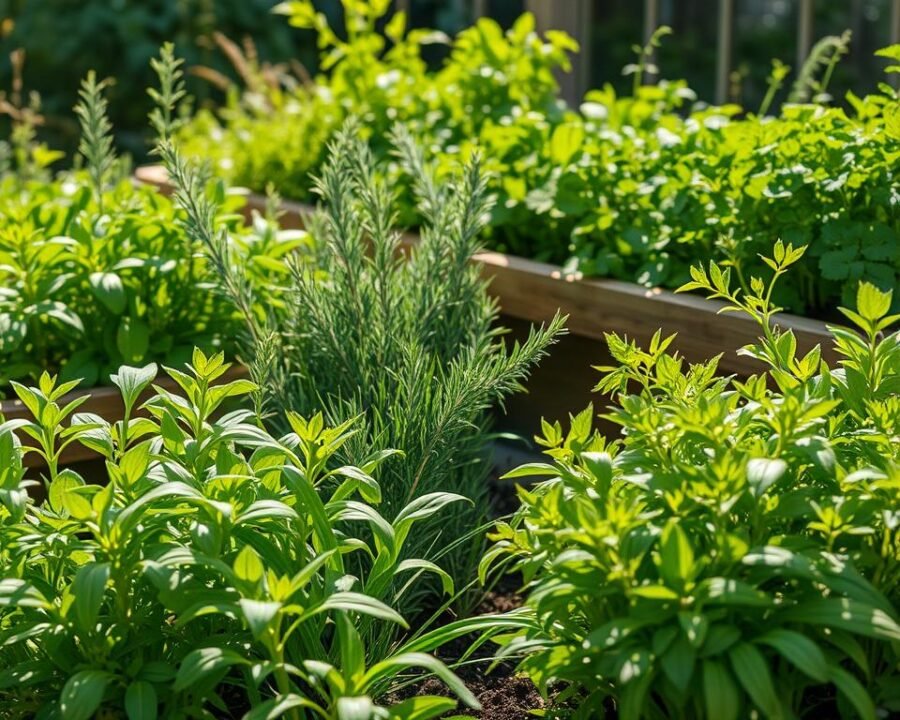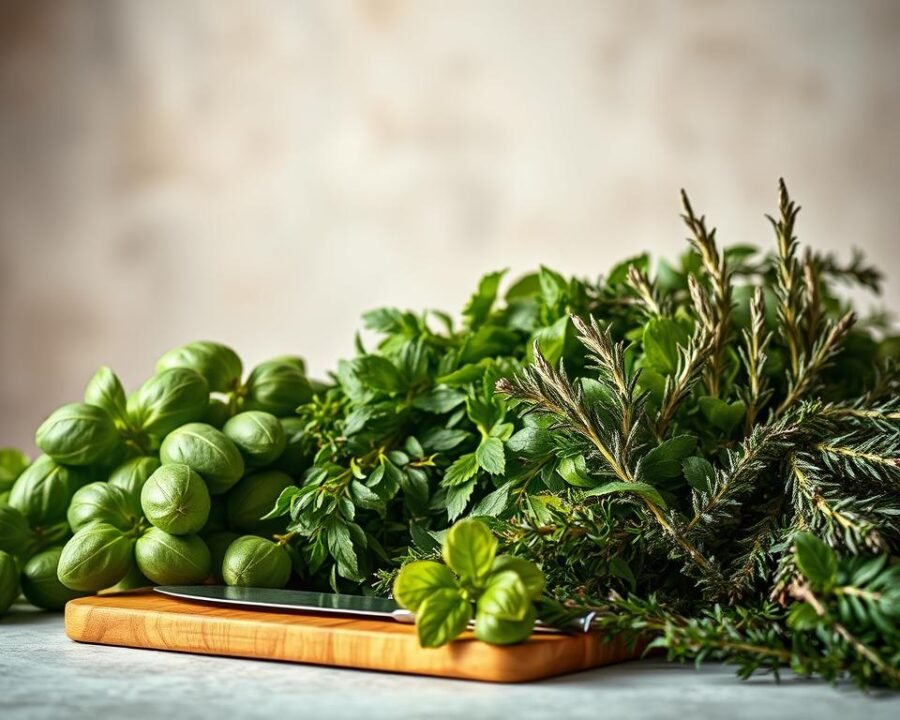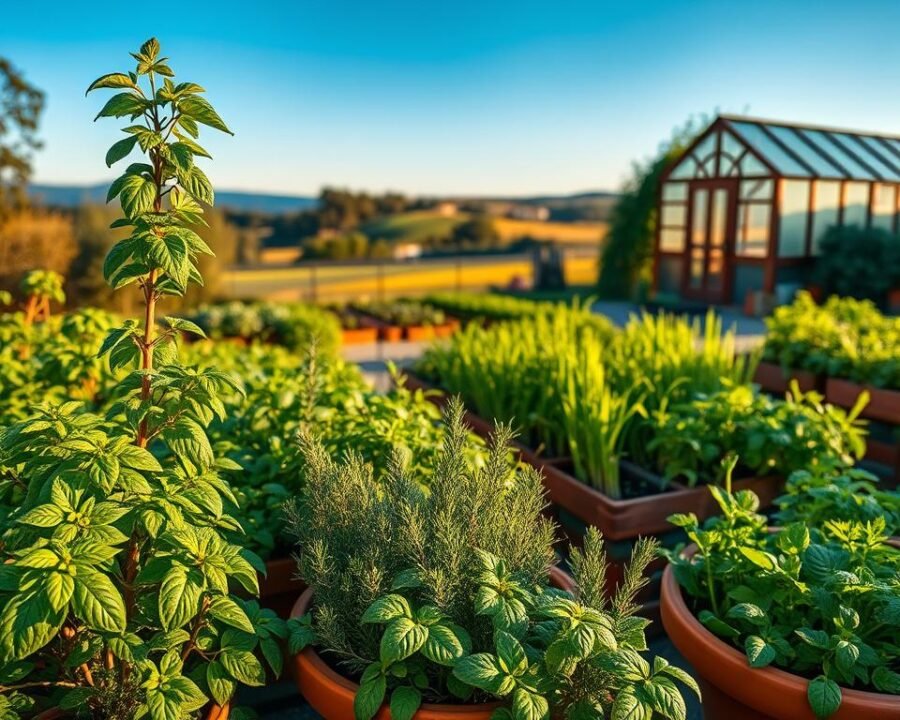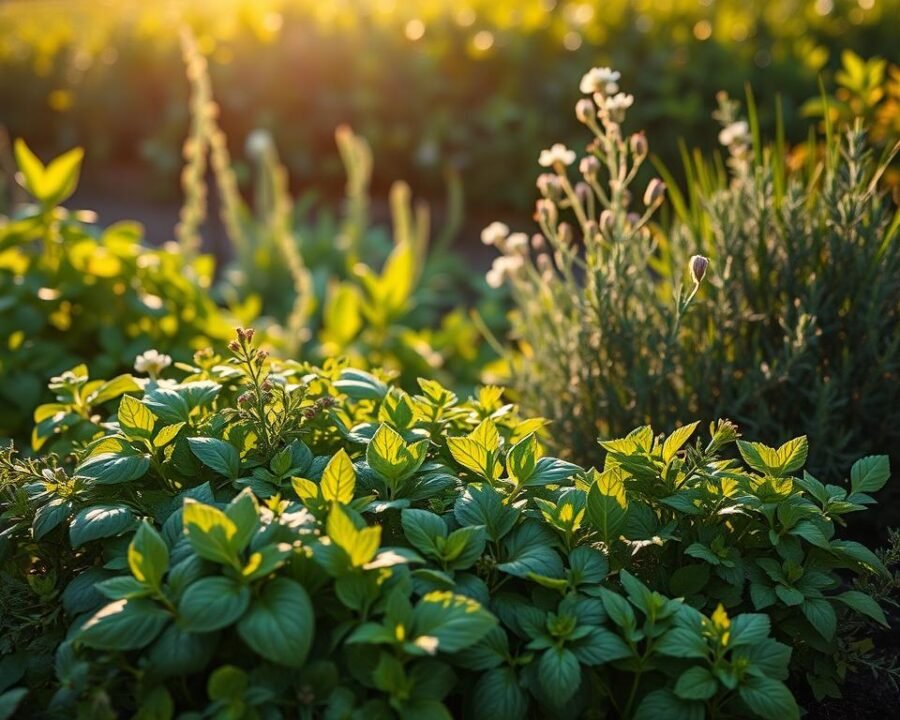There’s something magical about stepping outside and snipping fresh herbs for a meal. Whether it’s the earthy aroma of rosemary or the bright zest of basil, homegrown flavors elevate every dish. Even a tiny balcony or sunny windowsill can become a thriving herb garden with the right picks.
We’ve curated 15 standout varieties, from classic kitchen staples like thyme to decorative beauties like lavender. Experts like Janet Loughrey and Proven Winners guided our selections, ensuring each plant offers both culinary and visual appeal. No matter your skill level, these choices bring flavor and vitality to any space.
Key Takeaways
- Fresh herbs enhance meals and require minimal space.
- Fifteen expert-approved varieties suit different tastes and needs.
- Options include both culinary essentials and decorative plants.
- Easy-growing tips help beginners succeed.
- Balconies and windowsills work perfectly for small gardens.
Why Grow Your Own Garden Herbs?
Nothing beats the vibrant taste of just-picked leaves in your favorite dishes. Whether tossed into salads or simmered in soups, homegrown varieties pack a flavor punch that store-bought options can’t match. Beyond taste, cultivating your own offers surprising perks.
Fresh Flavors at Your Fingertips
Basil’s volatile oils, for example, are 3x more potent when harvested fresh. A single sprig of mint can elevate iced tea or garnish desserts within hours of picking. Compare that to supermarket bunches, which lose 40% of their aroma after 48 hours.
Health and Nutritional Benefits
Parsley delivers a day’s worth of Vitamin K per tablespoon, while rosemary contains antioxidants linked to brain health. Studies show sage boasts over 150 polyphenols—compounds that support immunity. Here’s a quick nutrient breakdown:
- Vitamin C: Thyme (3x more than oranges)
- Iron: Dill (as much as spinach)
- Fiber: Fennel (supports digestion)
Cost-Effective and Sustainable
A $4 mint plant yields 200+ sprigs annually—equivalent to $20 at grocery stores. Plus, you’ll skip plastic clamshell packaging. One windowsill planter can thrive for years with minimal care.
| Herb | Store Price (per year) | Homegrown Savings |
|---|---|---|
| Basil | $15 | $12 |
| Parsley | $10 | $8 |
| Oregano | $12 | $9 |
Even small spaces work. A Brooklyn apartment dweller kept a thriving herb collection for 3+ years using just a sunny ledge.
15 Best Garden Herbs You Need to Try
Fresh flavors burst from homegrown plants, transforming everyday meals. These selections blend culinary versatility with visual appeal, suited for pots or plots.
Basil: The Versatile Kitchen Staple
Genovese basil offers large, sweet leaves ideal for pesto, while Thai basil adds spicy depth to stir-fries. Both thrive in warm, sunny spots.
Rosemary: Aromatic and Robust
This woody perennial survives winter indoors in 6″ pots under grow lights. Its piney scent enhances roasted dishes.
Oregano: Spicy and Easy to Grow
Pair with roasted vegetables using a 1:3 oregano-thyme ratio. Mexican varieties pack more heat than Italian.
Lavender: Calming and Decorative
Use dried flowers in sachets or infuse lemonade. Four preservation methods extend its shelf life.
Lemon Verbena: Citrusy and Refreshing
High oil concentration makes it perfect for teas. The leaves retain flavor even when dried.
Parsley: Mild and Nutrient-Rich
This biennial yields continuous harvests. Flat-leaf types blend smoothly into sauces.
Sage: Piney and Perfect for Meats
Crush sage leaves with garlic for a pork chop rub. Its antioxidants support brain health.
French Tarragon: A Gourmet Favorite
An essential in Béarnaise sauce. Plant in well-draining soil to prevent root rot.
Thyme: Earthy and Versatile
English thyme suits soups, while lemon varieties brighten salads. Both tolerate partial sun.
Chives: Mild Onion Flavor
Snip fresh into scrambled eggs or baked potatoes. Their purple flowers are edible.
Mint: Bright and Invigorating
Containers prevent invasive roots. Peppermint thrives in shade; spearmint prefers full sun.
Cilantro: Pungent and Popular
Harvest before bolting for optimal flavor. A key ingredient in salsas and curries.
Dill: Sharp and Great for Pickling
Feathery fronds elevate fish dishes. Attracts beneficial insects to the garden.
Fennel: Savory-Sweet and Multipurpose
Bulbs roast beautifully, while seeds aid digestion. Bronze varieties add ornamental appeal.
German Chamomile: Soothing and Therapeutic
Steep tea at 208°F for maximum relaxation. Self-seeds readily for low-maintenance growth.
How to Start Your Herb Garden
Growing your own herbs is simpler than you might think. With a few basics, even beginners can cultivate a lush, flavorful collection. Let’s break down the essentials.
Choosing the Right Location
Most herbs crave sunlight. A sunny spot with 6+ hours of direct light suits Mediterranean varieties like rosemary. For mint or parsley, 4 hours in partial shade works.
Indoors? South-facing windows are ideal. Apps like Sun Surveyor help track light patterns. Avoid drafty areas—consistent warmth matters.
Container vs. Ground Planting
Containers offer flexibility. Use 12″-deep pots for woody herbs like sage. Thyme thrives in 6″ pots. Mint needs root barriers—its spread is aggressive.
In-ground planting suits spacious yards. Ensure well-draining soil to prevent waterlogging. Raised beds are a smart middle ground.
Soil and Sunlight Requirements
Herbs prefer slightly acidic to neutral soil (pH 6.0–7.5). Sage leans alkaline; mint favors neutral. Mix in compost for nutrients.
Sunlight needs vary:
- Full sun: Basil, oregano (6+ hours)
- Partial shade: Chives, cilantro (4 hours)
| Herb | Soil pH | Container Depth |
|---|---|---|
| Rosemary | 6.0–7.0 | 12″ |
| Thyme | 6.0–7.5 | 6″ |
With these conditions, your plants will flourish. Start small, observe, and expand as confidence grows.
Easy-to-Grow Herbs for Beginners
New to gardening? These resilient herbs make success almost effortless. Parsley, mint, and chives adapt to various conditions, offering steady harvests with minimal fuss. Perfect for windowsills or small plots, they’re ideal starter plants.

Parsley: Slow but Steady
Parsley tests patience but rewards persistence. Soak seeds overnight to speed up germination, which typically takes 30 days. Once sprouted, it thrives for months.
Flat-leaf varieties blend smoothly into salads and sauces. Unlike many herbs, it tolerates light shade, making it versatile for indoor setups.
Mint: Vigorous and Forgiving
Mint grows aggressively—even from supermarket sprigs. Follow this 3-step rooting guide:
- Trim 4″ stems below a leaf node.
- Place in water until roots appear (7–10 days).
- Transfer to soil, keeping leaves dry.
Avoid overwatering; it’s the top mistake beginners make. Containers prevent invasive spreading.
Chives: Hardy and Productive
Chives rebound quickly after harvesting. Cut 3″ above the soil, and they regrow 75% of their mass within weeks. Their purple flowers add color to dishes.
In Zone 5 winters, they survive under mulch, unlike more delicate herbs. Divide clumps every 3 years to maintain vigor.
| Herb | Winter Survival (Zone 5) | Key Tip |
|---|---|---|
| Parsley | Biennial (needs protection) | Cover with straw |
| Mint | Perennial (dies back, regrows) | Cut stems to ground |
| Chives | Perennial (hardy to -30°F) | Mulch lightly |
Start with these three, and soon you’ll expand your garden confidently. Each offers unique flavors and resilience, proving that anyone can grow herbs successfully.
Herbs That Thrive in Containers
Limited space doesn’t mean sacrificing fresh flavors. Many aromatic plants flourish in pots, bringing vibrant tastes to balconies, patios, or kitchen counters. With the right care, these varieties yield bountiful harvests without sprawling across garden beds.
Basil: Perfect for Sunny Windowsills
Basil loves warmth and light. A south-facing window with 6+ hours of sun keeps it thriving. For darker spaces, LED grow lights under $30 provide ample brightness.
Keep soil moist but not soggy. Pinch off flower buds to prolong leaf production. Container-grown basil yields 15% less than ground-planted ones but matures faster—ideal for quick harvests.
Thyme: Compact and Low-Maintenance
This drought-tolerant herb fits perfectly in small pots. Its shallow roots adapt well to 6″ containers. A DIY self-watering system using cut 2-liter bottles ensures consistent moisture without overwatering.
Place thyme where it gets full sun. Varieties like English thyme work in soups, while lemon thyme brightens salads. Both resist pests naturally.
Oregano: Spills Beautifully Over Edges
Oregano’s trailing habit makes it ideal for hanging baskets or cascading planters. Regular trimming prevents legginess and encourages bushier growth. Its flavor intensifies when dried.
Pair with rosemary or sage in shared containers—they enjoy similar dry conditions. Avoid overcrowding; give each plant 8″ of space.
| Herb | Container Type | Key Tip |
|---|---|---|
| Basil | 8″-deep pot | Rotate daily for even light |
| Thyme | 6″ self-watering | Water only when soil feels dry |
| Oregano | Hanging basket | Trim weekly for shape |
Creative containers add charm. Try upcycled colanders, rain boots, or teapots for a playful touch. Just ensure drainage holes to prevent root rot.
Herbs for Culinary Delights
Herbs aren’t just for garnish—they’re the secret to unforgettable dishes. Whether simmered, blended, or sprinkled fresh, they unlock layers of flavor in every kitchen creation. Let’s explore how to maximize their potential.

Enhancing Soups and Stews
Oregano and thyme are soup superstars. For a balanced flavor, use 1 tbsp fresh oregano per 4 servings. Add woody herbs like rosemary early; delicate ones like parsley at the end.
Freeze herb-infused oils in ice cube trays for quick use. One cube equals 2 tsp fresh—perfect for last-minute soups.
Elevating Salads and Dressings
Lemon verbena brightens dressings. Try this ratio:
- 3 tbsp olive oil
- 1 tbsp lemon juice
- 1 tsp chopped verbena
Chives and dill elevate salads. Their mild flavors pair well with vegetables like cucumbers and tomatoes.
Flavoring Meats and Poultry
Sage’s piney notes complement pork, while rosemary excels with chicken. Create rubs using this matrix:
| Herb | Best Protein Pairing |
|---|---|
| Sage | Pork chops |
| Rosemary | Roast chicken |
| Thyme | Grilled fish |
Mint isn’t just for drinks—it tenderizes lamb. Its 23 cocktail uses include mojitos and herbal syrups.
Health Benefits of Garden Herbs
Beyond flavor, homegrown herbs offer surprising wellness perks. Science reveals their potent compounds support everything from digestion to brain function. Let’s explore how these humble plants elevate well-being.
Antioxidant-Rich Powerhouses
Rosemary and sage lead with impressive ORAC scores—a measure of antioxidant strength. Crushed sage leaves contain rosmarinic acid, linked to memory enhancement in studies. Compare their potency:
- Rosemary: 3,300 ORAC (near blueberries’ 4,669)
- Thyme: 27,426 ORAC per 100g
Add fresh leaves to oils or rubs for a health boost.
Digestive Support Heroes
Peppermint tea soothes IBS symptoms—2 cups daily reduced bloating by 40% in trials. Dill’s anti-inflammatory effects aid digestion, while fennel seeds relieve cramps. Post-meal options:
- Chamomile tea (relaxes stomach muscles)
- Ginger-infused water (speeds digestion)
Natural Stress Relievers
Lavender sachets lowered anxiety by 32% when placed near pillows. Chamomile’s apigenin binds to brain receptors, promoting sleep. For quick calm:
| Herb | Preparation | Effect |
|---|---|---|
| Lemon balm | Tea (steeped 5 min) | Reduces restlessness |
| Holy basil | Chewed fresh | Lowers cortisol |
These plants prove that small choices—like sipping herbal tea—can transform daily health.
Seasonal Herb Growing Tips
Timing matters when growing flavorful herbs—each season brings unique opportunities. Adjusting care for sun, soil, and temperature ensures vibrant harvests year-round. Whether battling summer heat or winter frosts, these tips keep plants thriving.

Spring and Summer Favorites
Basil and dill flourish in warm conditions. Plant after the last frost when soil reaches 60°F. For zones 5–7, this typically falls between April and May.
Heatwaves demand shade cloth (30% coverage). A pro tip:
“Water basil at the base in early morning to prevent leaf scorch.”
Fall and Winter Survivors
Rosemary needs winter protection below 20°F. Potted plants benefit from:
- Mulching the base with straw
- Moving to a south-facing window
- Reducing watering to twice monthly
Parsley sweetens after frost, making it a cold-season staple.
Year-Round Growers
Chamomile self-sows yearly, while thyme tolerates mild winters. Indoors, use grow lights for 12–14 hours daily. This schedule mimics summer sun.
| Herb | First Frost Date | Last Frost Date |
|---|---|---|
| Basil | October 15 | April 20 |
| Rosemary | November 1 | March 30 |
With these adjustments, your herb garden adapts seamlessly to every season.
Common Mistakes to Avoid
Even experienced growers face challenges when cultivating flavorful plants. Recognizing these pitfalls early saves time and boosts harvests. Let’s explore three frequent missteps and simple solutions.
Watering Woes: Finding the Balance
Overwatering drowns roots, while underwatering stresses plants. Check soil moisture with the 1-inch rule—if dry below the surface, it’s time to water. Signs to watch:
- Overwatered: Yellow leaves, moldy soil
- Underwatered: Crispy edges, drooping stems
Mint needs daily summer drinks, but rosemary thrives on weekly sips. Adjust based on conditions like heat and humidity.
Space Matters: Avoiding the Crowd
Plants compete fiercely for resources when cramped. Follow these spacing tips:
| Plant | Minimum Space |
|---|---|
| Basil | 12 inches |
| Thyme | 8 inches |
Crowding causes five key issues, from stunted growth to nutrient lockout. Mint spreads 36 inches—contain it in pots or bordered beds.
Harvest Habits: Regular Trims Reward
Neglecting to prune reduces yields and quality. Basil produces 30% more when trimmed every 3 weeks. For continuous cilantro, succession planting every 2 weeks works best.
Harvesting tips:
- Snip above leaf nodes to encourage branching
- Morning cuts preserve essential oils
- Never remove more than ⅓ of leaves at once
With these adjustments, your garden thrives while avoiding common pitfalls.
Conclusion
Turning a small space into a thriving green corner starts with resilient plants. Basil, mint, and chives lead as beginner-friendly picks—for under $20, they deliver steady harvests with minimal fuss.
Ready to level up? Hydroponic systems can triple yields in tight spaces. Grab our free herb journal to track growth and recipes.
In just 8 weeks, that first pesto will prove how simple—and rewarding—a herb garden can be. Start small, savor the process, and let flavors flourish.
